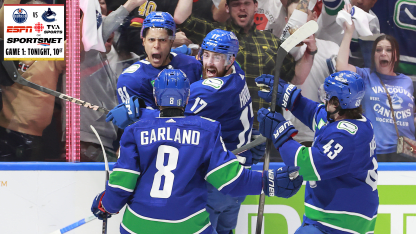VANCOUVER -- Teddy Blueger sees similarities between the Vancouver Canucks' defensemen this season and the Vegas Golden Knights' defensive core he won the Stanley Cup with last season.
With the exception of the top pair of Quinn Hughes, who was named a finalist for the Norris Trophy as the NHL’s top defenseman on May 1, and Filip Hronek, the Canucks rebuilt their defense with an eye toward the size, reach and physicality of last year’s Cup champions.
To go with Tyler Myers (6-foot-8, 229 pounds), the Canucks added Carson Soucy (6-5, 208 pounds) and Ian Cole (6-1, 225 pounds) in free agency and acquired Nikita Zadorov (6-6, 248 pounds) from the Calgary Flames on Nov. 30. Even with Hughes (5-10, 180 pounds) and Hronek (6-foot, 190 pounds), Vancouver’s defense averages 6-foot-3 and 213 pounds, the same height and one pound heavier than Vegas' defense last season.
“Obviously, ‘Huggy’ and ‘Fil’ aren't the biggest guys, but we’ve got probably even bigger guys, actually, so in that sense there's similarity,” said Blueger, a center who played six playoff games for Vegas last season. “The physicality they bring, the way they defend with a long reach, I can see some similarities for sure.”
Vancouver’s defense was effective in helping to eliminate the Nashville Predators in six games in the Western Conference First Round, only giving up 12 goals and finishing 20-for-22 (90.9 percent) on the penalty kill. It may have been the best they’ve played this season, especially in front of their net, coach Rick Tocchet said.
“All year the [defense] has been somewhat of the fabric of our team, the way we play defense, but they did a great job with the interior,” Tocchet said. “For me, they did a really good job of protecting the high-danger interior stuff.”
They did it against a Nashville team that ranked second in the NHL in scoring (3.71 goals per game) and on the power play (27.2 percent) after the All-Star Break. But things get harder in the second round against the Edmonton Oilers, who averaged 4.40 goals per game and scored on 9-of-20 power plays (45 percent) against the Los Angeles Kings, who they eliminated in five games in the first round.
The Canucks hope the size, reach and skating of their defense can slow Edmonton down at least a little, although the Oilers still averaged 3.5 goals per game in the second round against Vegas last postseason (lost in six games).
“They're just hard to play against,” Blueger said of the Canucks defense. “Anytime you're up against a big guy, especially guys that like to be physical, it makes it hard. You’ve really got to battle, so that side of it is important, and also they have long reaches, good sticks, so they can get to plays, break up plays probably a little more than guys with shorter sticks and shorter reaches. And I think the biggest thing is they're not just big, but they all move really well. They can skate.”
Vancouver certainly isn’t the only team that believes a big defense is important in the playoffs. The Oilers limited Los Angeles to 13 goals in the first round and killed off all 12 power plays with a defense that is one inch taller than the Canucks, with an average height of 6-foot-4, and just marginally lighter at 210 pounds.
“Big guys with long reach that skate well, you cover more space, you're heavier to get around, you can withstand a little more physical play in your own end,” said Cole, who won the Stanley Cup with the Pittsburgh Penguins in 2016 and 2017.
“Every team tries to put pucks in and run the defensemen this time of year. If you can withstand that, take those hits, make the plays, get out of your end, you spend a lot less time in your zone, which is kind of what we like to try to do.”
Soucy said the key against Edmonton is to not chase their top forwards.
“Using our reach allows us to stay inside a little more, so hopefully we can stay composed when they get their offensive shifts, get moving around,” he said. “We just have to stay tight and use that reach, close it down when we can.”



















